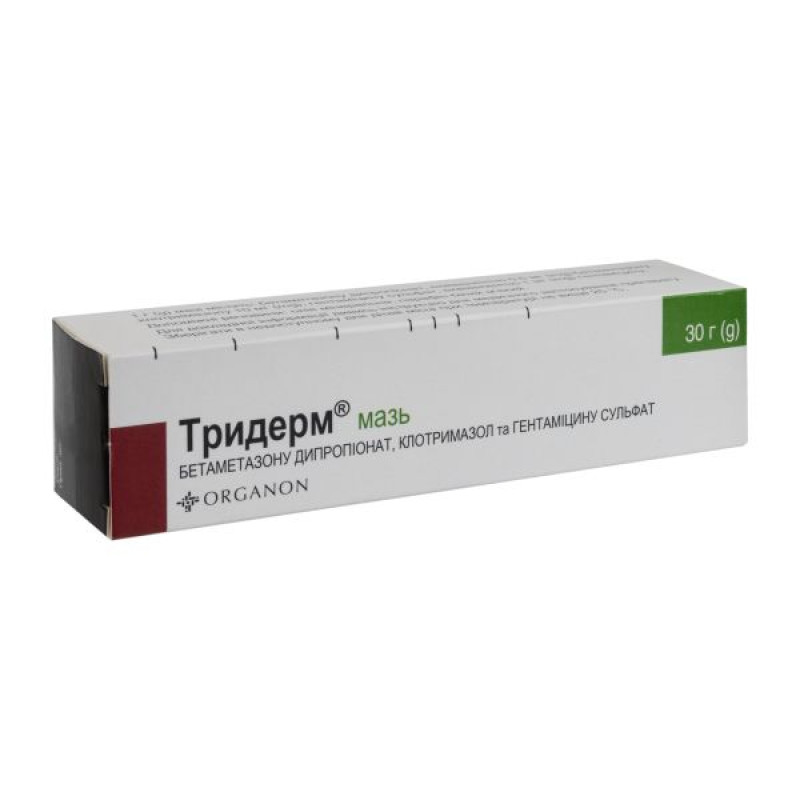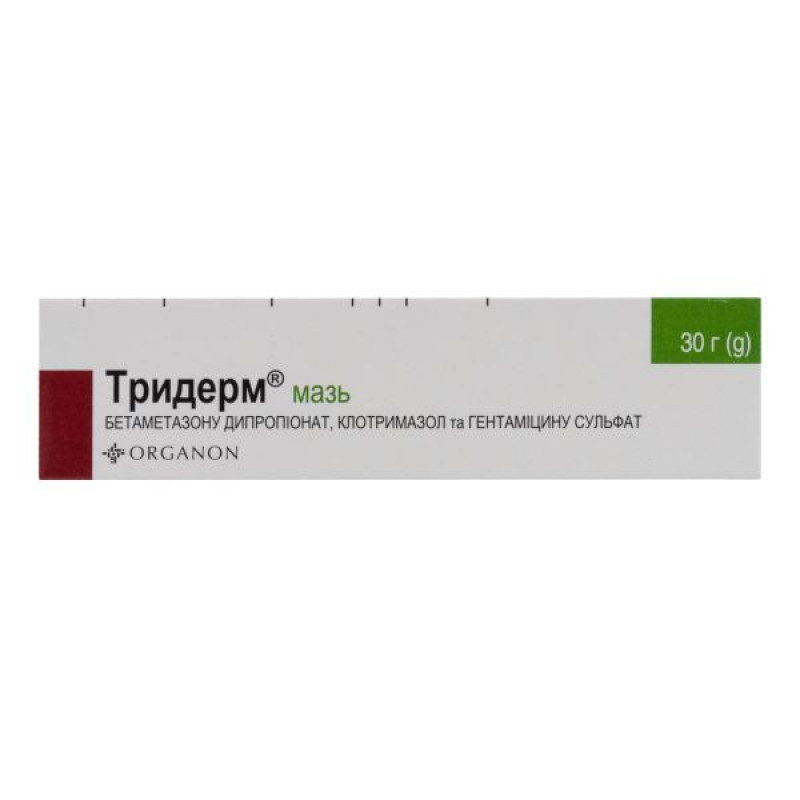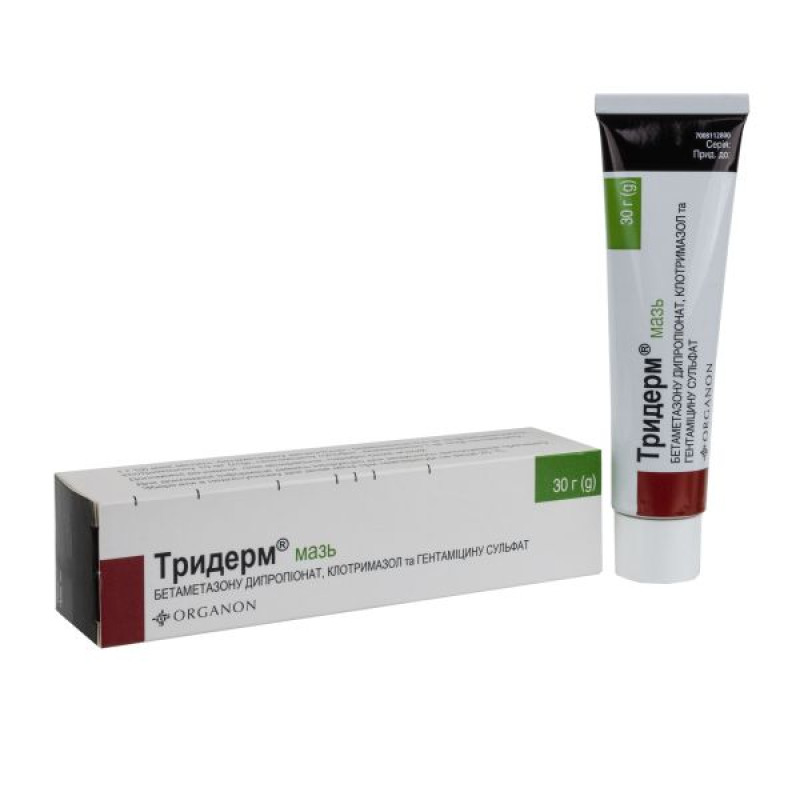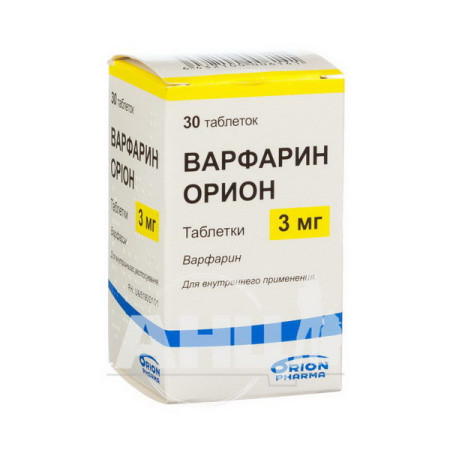Triderm ointment tube 30 g

Instructions Triderm ointment tube 30 g
Composition
active ingredients: 1 g of ointment contains: betamethasone dipropionate equivalent to betamethasone 0.5 mg, clotrimazole 10 mg and gentamicin sulfate equivalent to gentamicin 1 mg;
excipients: mineral oil, white soft paraffin.
Dosage form
Ointment.
Main physicochemical properties: soft consistency, white to light yellow, homogeneous ointment without foreign impurities.
Pharmacotherapeutic group
Corticosteroids for use in dermatology. Corticosteroids in combination with antibiotics. Betamethasone and antibiotics. ATX code D07C C01.
Pharmacological properties
Mechanism of action.
Triderm® combines three actions: the anti-inflammatory action of betamethasone dipropionate with the antibacterial activity of gentamicin sulfate and the antifungal action of clotrimazole.
Pharmacodynamics
Betamethasone dipropionate is a potent (class III) corticosteroid with anti-inflammatory, antiallergic, and antipruritic effects.
Gentamicin is an aminoglycoside antibiotic with bactericidal activity. It inhibits protein synthesis in susceptible microorganisms. Gentamicin is active against many aerobic gram-negative and few gram-positive bacteria. In vitro, gentamicin at a concentration of 1–8 μg/ml inhibits most susceptible strains of Escherichia coli, Haemophilus influenzae, Moraxella lacunata, Neisseria, indole-positive and indole-negative strains of Proteus, Pseudomonas (including most strains of Pseudomonas aeruginosa), Staphylococcus aureus, Staphylococcus epidermidis and Serratia. Different species and strains of the same species may exhibit significant differences in in vitro susceptibility. In addition, in vitro susceptibility does not always correlate with in vivo susceptibility. Gentamicin is ineffective against most anaerobic bacteria, fungi and viruses. Gentamicin is only minimally effective against streptococci.
Resistance to gentamicin can develop in gram-negative and gram-positive bacteria.
Clotrimazole is a synthetic, antifungal agent of the imidazole derivative group. The spectrum of activity includes a number of fungi that are pathogenic to humans and animals. Clotrimazole provides effective action against dermatophytes, yeasts and molds. In vitro tests have demonstrated the effectiveness of clotrimazole against Trichophyton rubrum, Trichophyton mentagrophytes, Epidermophyton floccosum, Microsporum canis and Candida (including Candida albicans). Based on current knowledge, the antifungal action of clotrimazole is due to inhibition of ergosterol synthesis. Ergosterol is an important component of the cell membrane of fungi.
Pharmacokinetics
No penetration or absorption studies have been conducted for this medicinal product.
Betamethasone
Under normal conditions, only a portion of topically applied betamethasone is systemically available. The extent of penetration depends on the site of application, skin condition, dosage form used, patient age, and route of administration.
Gentamicin
Absorption can be disregarded when gentamicin is applied to intact skin. However, increased transdermal absorption should be considered in cases of loss of the keratin layer, inflammation, and application under occlusive dressings/on large skin surfaces.
Clotrimazole
After application, systemic absorption is low, with most of the clotrimazole remaining in the stratum corneum. The following concentrations were observed 6 hours after application of 1% radioactive clotrimazole to intact skin and to skin with acute inflammation: stratum corneum ˗ 100 μg/cm³, stratum reticulum ˗ 0.5–1 μg/cm³, subcutaneous layer ˗ 0.1 μg/cm³.
Indication
Treatment of dermatoses sensitive to corticosteroids in the presence (or suspicion) of bacterial and/or fungal infections caused by microorganisms sensitive to the components of the drug.
Contraindication
Contraindications for topical corticosteroids include skin infections [viral, bacterial (including tuberculosis) and fungal], skin reactions after vaccination, skin ulcers and acne. It is not recommended to apply the ointment in the presence of rosacea or perioral dermatitis. The drug is contraindicated in patients with hypersensitivity to the active substances or to any other component of the drug, other aminoglycoside antibiotics (cross-allergic reactions to gentamicin) or imidazole derivatives (cross-allergic reactions to clotrimazole).
Triderm® is not indicated for use under occlusive dressings.
Triderm® should not be applied to mucous membranes, eyes or the area around the eyes.
Interaction with other medicinal products and other types of interactions
When applying the ointment to the skin of the genitals and anal area, the presence of soft paraffin or liquid paraffin (excipients in the preparation) may reduce the tensile strength of latex condoms, thereby reducing their reliability during use.
Clotrimazole, when applied topically, may be an antagonist of amphotericin and other polyene antibiotics.
Application features
The ointment is particularly suitable for use on dry or rough skin.
If skin irritation or hypersensitivity develops during treatment with Triderm® ointment, the use of the drug should be discontinued and adequate therapy should be selected for the patient.
With topical application, systemic absorption of the active substances may be higher when the drug is applied to large areas of skin, with prolonged use or when applied to damaged skin areas. In this case, side effects such as those observed after systemic use of the active substances may occur. With concomitant systemic administration of aminoglycoside antibiotics, in case of increased absorption, the possibility of cumulative toxic effects (ototoxicity/nephrotoxicity) should be taken into account.
In particular, cross-allergic reactions with other aminoglycoside antibiotics should be borne in mind.
Long-term topical use of antibiotics can sometimes lead to the growth of resistant microflora. In this case, as well as in the event of the development of superinfection, appropriate treatment should be prescribed.
The use of the drug in high doses, on large body surfaces or with corticosteroids of strong or very strong action should only be done under regular medical supervision; especially with regard to the suppression of endogenous corticosteroid production and possible metabolic effects.
Avoid applying the drug to open wounds or damaged skin.
Continuous treatment for more than 2–3 weeks is not recommended.
Prolonged continuous or incorrect use of topical steroids may lead to rebound effects at the end of treatment (topical steroid withdrawal syndrome). Severe rebound effects may develop as dermatitis with intense redness, tingling and burning, which may extend beyond the area initially treated. The likelihood of a reaction is higher if sensitive skin areas are treated, such as the face or flexural areas of the extremities. If the original symptoms return within a few days or weeks after successful treatment, a withdrawal reaction may be suspected (see “Adverse reactions”). Re-application should be carried out with caution, and in these cases a specialist should be consulted or another type of treatment should be considered.
Very potent, potent, and moderate-potency corticosteroids should be used with caution on the face and genitals, and the duration of treatment should not exceed 1 week.
Corticosteroids may mask the symptoms of an allergic reaction to one of the components of the drug. The patient should be instructed to use the drug only for personal treatment of an existing skin condition and not to share it with others.
Visual impairment may occur with systemic and topical corticosteroids (including intranasal, inhaled, and intraocular administration). If symptoms such as blurred vision or other visual disturbances occur, the patient should be evaluated by an ophthalmologist to evaluate possible causes of visual impairment, which may include cataracts, glaucoma, or rare conditions such as central serous chorioretinopathy, which have been reported following the use of systemic and topical corticosteroids.
Children.
Pediatric patients may be more susceptible to topical corticosteroid-induced hypothalamic-pituitary-adrenal (HPA) suppression and Cushing's syndrome than adult patients due to a larger skin surface area to body mass ratio.
Children receiving topical corticosteroids have been reported to have suppression of the function of the adrenal cortex, Cushing's syndrome, growth retardation, failure to gain weight, and increased intracranial pressure.
Manifestations of adrenal cortex suppression: low plasma cortisol levels and no response to the adrenal stimulation test with adrenocorticotropic hormone (ACTH) drugs. Increased intracranial pressure is manifested by fontanelle protrusion, headache, and bilateral optic disc edema.
Use during pregnancy or breastfeeding
Pregnancy
Teratogenic effects of topical corticosteroids have been demonstrated in experimental animal studies. There are no data on their use during human pregnancy.
Aminoglycosides cross the placental barrier and may cause fetal harm when administered to pregnant women. There have been reports of complete irreversible bilateral congenital deafness in children whose mothers received aminoglycosides (including gentamicin) during pregnancy. There are insufficient data on the use of topical gentamicin in pregnant women. There are insufficient data on the use of clotrimazole in pregnant women.
Animal studies have not demonstrated a risk of exposure to the drug on the fetus.
Triderm® should only be used when absolutely necessary.
Triderm® should not be used in large doses, on large areas of skin, or for long periods of time.
Lactation
It is not known whether topical gentamicin, clotrimazole, and corticosteroids are excreted in human milk. However, systemic corticosteroids are found in human milk.
Triderm® should not be applied to the mammary glands during breastfeeding.
Ability to influence reaction speed when driving vehicles or other mechanisms
The effect on the ability to drive vehicles or operate other automated systems has not been studied.
Method of administration and doses
Adults: Apply a thin layer of Triderm® to the entire affected area and adjacent intact skin twice a day, morning and evening, and rub in gently. The duration of treatment depends on the patient's clinical response to treatment, as well as clinical and microbiological parameters.
In cases of athlete's foot, a longer course of treatment (2–4 weeks) may be necessary.
Children
It is not recommended for use in children, as there is no experience with the use of the drug in patients of this age category.
Overdose
Symptoms: With prolonged or excessive use of local glucocorticosteroids, suppression of the pituitary-adrenal system is possible with the development of secondary adrenal insufficiency and the appearance of symptoms of hypercorticism, including Cushing's disease.
It cannot be ruled out that a single overdose of gentamicin leads to the appearance of overdose symptoms.
Excessive and prolonged use of gentamicin may lead to overgrowth of microorganisms insensitive to the antibiotic at the site of skin lesions.
Treatment. Appropriate symptomatic therapy is prescribed. Symptoms of acute hypercorticism are usually reversible. If necessary, correction of electrolyte balance should be carried out. In case of chronic toxicity, gradual withdrawal of corticosteroids is recommended.
In case of overgrowth of resistant microorganisms, it is recommended to discontinue treatment with Triderm® and prescribe the necessary antifungal or antibacterial therapy.
Adverse reactions
Starting treatment
From the skin side
Rare: skin irritation, burning sensation, itching, dry skin, hypersensitivity reactions to one of the components of the drug and skin discoloration.
Use on large areas of skin, under occlusive dressings and/or for prolonged periods (see "Contraindications")
When used on large areas of skin, under occlusive dressings and/or for a long time, local skin changes may occur. When used on large areas of skin, systemic reactions (adrenal suppression) may occur.
It is important to remember the increased risk of developing secondary infections due to reduced local resistance to infection.
From the skin side
Localized skin changes such as skin atrophy (particularly of the face), telangiectasia, striae, stretch marks, subcutaneous hemorrhages, purpura, steroid acneiform eruptions, rosacea-like/perioral dermatitis, hypertrichosis, and skin discoloration. It is not known whether these skin discolorations are reversible.
Uncommon: contact sensitization to gentamicin.
Frequency unknown: withdrawal syndrome - redness of the skin, which may spread beyond the initially affected area, burning or tingling sensation, itching, peeling of the skin, fluid discharge from the vesicles (see "Special instructions").
Possible photosensitization has been observed in some patients; however, this effect is not reproduced by repeated administration of gentamicin followed by exposure to ultraviolet radiation.
From the endocrine system
Inhibition of endogenous corticosteroid synthesis, excessive adrenal activity with edema.
Metabolic
The appearance of latent diabetes mellitus.
From the organs of vision
Blurred vision.
From the side of the auditory organs, inner ear/from the side of the kidneys
With concomitant systemic use of aminoglycoside antibiotics, cumulative ototoxicity/nephrotoxicity may occur when Triderm® ointment is applied to large body surfaces or to affected skin areas.
From the musculoskeletal system
Osteoporosis, growth retardation (in children).
Expiration date
3 years.
Storage conditions
Store out of the reach of children at a temperature not exceeding 25 °C.
Packaging
15 g or 30 g in tubes. 1 tube in a cardboard box.
Vacation category
According to the recipe.
Producer
Organon Heist bv, Belgium/Organon Heist bv, Belgium
Location of the manufacturer and address of its place of business
Industriepark 30, 2220 Heist-op-den-Berg, Belgium.
There are no reviews for this product.
There are no reviews for this product, be the first to leave your review.
No questions about this product, be the first and ask your question.









